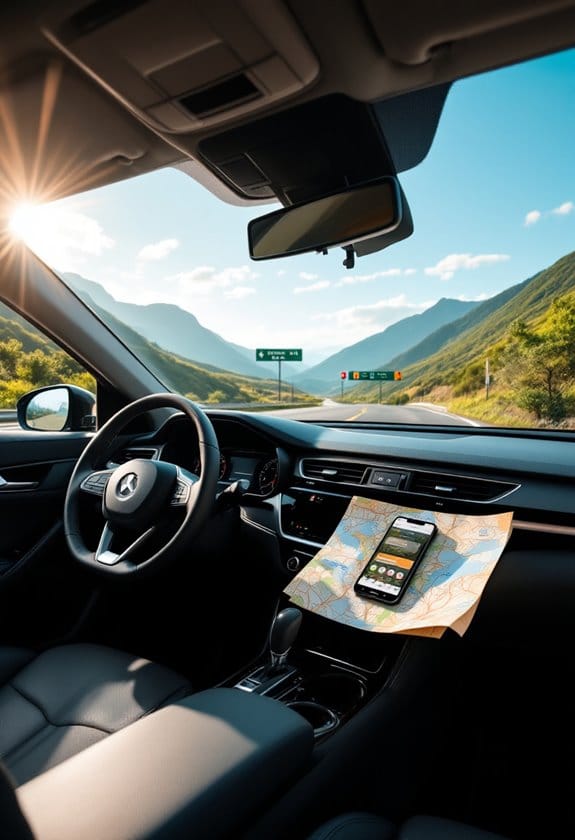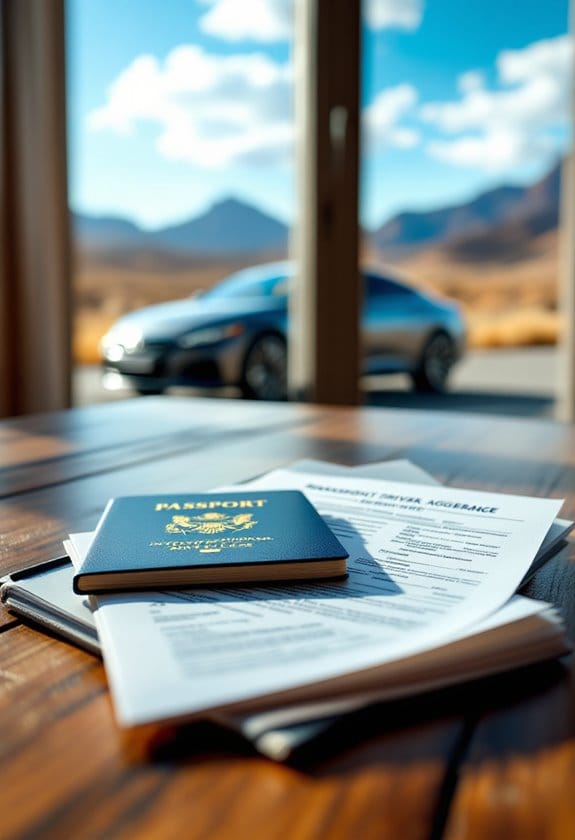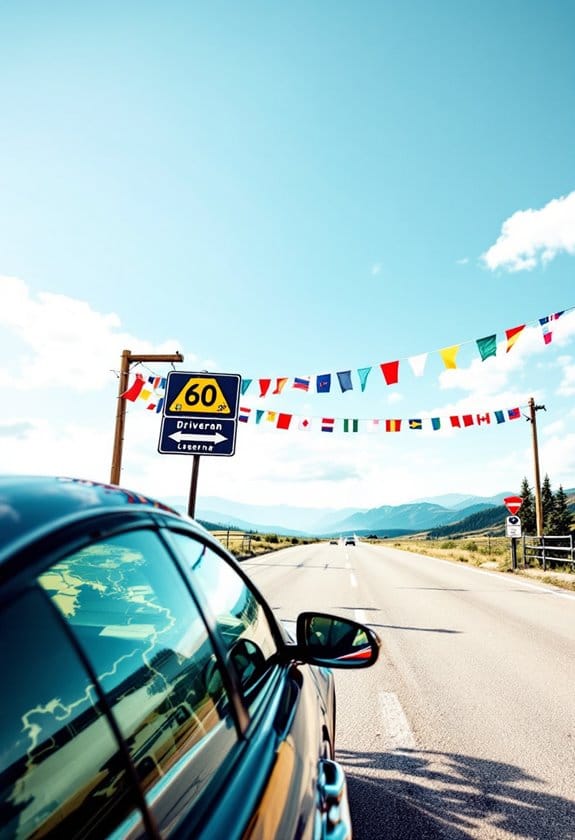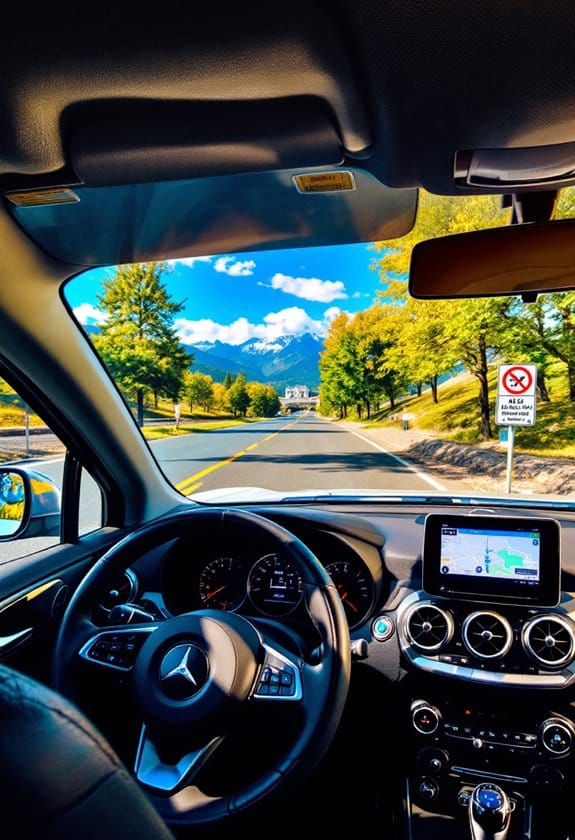So, you’re planning to hit the road and cross some borders with a rental car? Sweet! Just remember to check the rental company’s policies first—some charge extra fees for border crossings. And don’t forget to inform them of your travel plans; it’s essential for insurance coverage. Pack your passport, driver’s license, and any necessary insurance cards. Be aware of possible one-way fees and familiarize yourself with local driving laws; you might even encounter some amusing road signs! By keeping these tips in mind, you’ll be cruising across borders with ease, and there’s more to explore that can help you prep!
Key Takeaways
- Always inform the rental company about cross-border travel to ensure valid insurance coverage and obtain necessary permissions.
- Check for additional fees associated with border crossings, which can range from €15 to $35, depending on the route.
- Verify age restrictions and potential young driver fees, particularly if you’re under 25 or over 70 years old.
- Familiarize yourself with local driving laws and customs regulations of the destination country before your trip.
- Review the rental agreement for any location surcharges or additional costs related to one-way rentals across borders.
Understand Rental Company Policies
Understanding rental company policies is essential for a smooth travel experience. When you’re planning cross-border travel, it’s vital to explore those rental agreements. Each rental company has its own set of guidelines, and trust me, you don’t want to hit the road without knowing them. For instance, you might need to inform the company ahead of time, and some may even charge extra fees just for crossing the border. Imagine getting hit with unexpected charges right before your trip—yikes!
And let’s not forget about documentation. On trips between the US and Canada, you might need an enhanced driver’s license or even a NEXUS card. It’s all about being prepared. Plus, if you’re renting a luxury vehicle, you could face restrictions or additional costs. To ensure compliance, be aware that new documentation is required when booking your rental for cross-border trips.
Inform About Cross-Border Travel

Notifying your rental company about cross-border travel is essential for a hassle-free journey. When you’re booking that sweet ride, let them know which countries you plan to visit. This way, your car insurance stays valid, and you won’t hit any unexpected roadblocks. Trust me, not all rental companies are cool with border crossings, so check this out before you finalize your booking.
Keep in mind that some countries have special requirements, like needing a vignette, a fancy term for road tax. You’ll want to grab that as soon as you enter the country. Plus, if you’re considering a one-way rental, be ready for some hefty fees—plan your itinerary wisely to keep your wallet happy! Understanding cross-border policies is key to avoiding surprises during your trip.
Don’t forget about customs! Make sure everyone’s got their passports and necessary documents handy. And for smoother crossings, check out alternate routes and border wait times. Oh, and if you’ve got a NEXUS card, it can make your life a whole lot easier! So buckle up, stay informed, and enjoy the ride across those beautiful borders!
Verify Insurance Requirements

Before you hit the road with a rental car, it’s crucial to verify the insurance requirements to guarantee you’re fully protected. You wouldn’t want to find yourself in a sticky situation without the right insurance coverage, right? Most U.S. auto insurers won’t cover rentals outside of Canada and Mexico, so you may need to snag additional insurance from the rental company.
If you’re headed to Mexico, listen up! The Mexican border patrol demands you have a Mexico insurance policy. This includes liability, collision, extensive, and medical expenses. Imagine getting into a fender bender and realizing you’re not covered—yikes! Plus, every country has different laws, so it’s wise to check the specific liability options for each place you plan to visit. Remember, Mexico insurance is essential for compliance with Mexican border patrol regulations.
For those crossing into Canada, you generally won’t face issues, but be sure to inform your rental company, as they’ll need to confirm it’s okay in your agreement. Always carry your usual insurance card, and maybe a non-resident insurance card if required. Remember, it’s better to be safe than sorry when you’re enjoying that scenic drive!
Prepare Necessary Documentation

Gathering the necessary documentation is essential for a smooth rental car experience, especially if you’re planning to cross borders. You don’t want to be the one stuck at customs, fumbling through papers while everyone else breezes by. First, make sure your passport’s validity won’t expire anytime soon. Double-check that your driver’s license is valid too; it’s a must-have at border crossings!
Next, you’ll need to get that all-important rental approval from the company. They must document that the car is allowed to venture into another country, and this should be part of your rental agreement. If you’re heading to Canada, don’t forget to request a non-resident insurance card from your rental company—it shows you’re covered while cruising up north. Additionally, ensure that the rental company is informed of cross-border travel to avoid any complications at the border.
Also, keep your vehicle’s registration handy and be prepared for some questions from customs. If you’re a dual citizen or have permanent residency, expect a little extra chat! Finally, remember to keep all these documents easily accessible while driving. You’ll thank yourself when you sail through the border without a hitch!
Be Aware of Additional Fees

While having your documentation in order can help you breeze through the rental process, it’s equally important to be mindful of any additional fees that might catch you off guard. When you’re driving across borders, cross border costs can add up faster than you think. For instance, moving from the US to Canada with Alamo could set you back $35, while going from Germany to Austria might have Europcar charging $16. Ouch, right?
But here’s the kicker: if you forget to notify your rental company about your plans, you could invalidate your rental insurance. That means you’d be responsible for any damages, and trust me, you don’t want that headache! To ensure compliance with local laws and regulations, it’s crucial to understand the cross-border fee requirements of your rental company.
Also, don’t overlook one-way fees if you plan to drop the car off in a different country. And let’s not forget the sneaky VAT and location surcharges; picking up your car at an airport could hit you with a fee of €20 to €80. So, before you hit the road, take a moment to check the fine print and make sure you’re not in for any unexpected surprises. Happy travels!
Check Local Driving Laws

Understanding local driving laws is essential for a smooth rental experience. Before you hit the road, take a moment to familiarize yourself with the driving regulations in both the U.S. and Canada. While they both drive on the right side, speed limits can vary greatly from one jurisdiction to another, so don’t just assume they’re the same. In some areas, you might find yourself zooming along at 100 km/h, while in others, it could drop to 50 km/h before you know it!
Oh, and don’t forget to buckle up—seatbelt use is mandatory in both countries. Make sure your driver’s license is valid and, while you typically won’t need an International Driving Permit for crossing the U.S.-Canada border, it’s a good idea if you plan on venturing further afield. Additionally, verify if an International Driving Permit is required for any other countries you may visit.
Oh! And check with your rental company about cross-border travel policies. You wouldn’t want to get caught off guard if they have specific requirements. Trust me, knowing the rules can save you from hefty fines and a lot of stress. So, do your homework, and enjoy the ride!
Plan Your Itinerary Carefully

When planning your itinerary, it’s crucial to contemplate the specific policies of your rental company. You don’t want to hit the road only to find out that your rental company doesn’t allow cross-border routes into a country you’re keen to explore. Some companies might even charge you hefty fees for crossing borders, ranging from €15 to €50! So, check those policies before you pack your bags.
Make a detailed roadmap of your journey, noting destinations and distances. This helps you stay compliant with rental conditions and dodge those pesky mileage fees. And don’t forget about fuel considerations—some routes might require more gas than you think, especially if you’re driving in hilly or snowy areas. Additionally, understanding that cross-border travel may have specific restrictions in certain regions can help you avoid surprises.
Also, remember to inform the rental company about your travel plans. You might need special permissions or documents like an international driving permit, especially if you’re crossing into non-EU countries. Keep all necessary documents handy—rental agreements, insurance info, and border crossing permissions—so you can breeze through border controls without a hitch. Happy travels, and enjoy every mile!
Confirm Driver Age Restrictions

Confirming driver age restrictions is essential before renting a car, as these rules can vary considerably by country and rental company. You might be itching to hit the road, but if you’re under 21, you could run into some serious roadblocks. In many places, like Canada, the minimum age is usually 21, but in Saskatchewan and Quebec, it drops to 18. However, if you’re a young driver, be prepared for those pesky young driver fees.
And don’t think it’s just about being young; if you’re over 70, you might face some extra hurdles too. Countries like Croatia and the UK have restrictions for senior drivers, and in Greece, you may need to prove you’re still healthy enough to drive. Always double-check your rental agreements for any age verification requirements. Additionally, be aware that maximum age restrictions apply in some countries, such as Ireland, where drivers over 70 may face additional conditions.
Know About Car Category Limitations
Before hitting the road, it’s crucial to know about car category limitations, especially if you’re planning to travel across borders. Many rental companies, like Avis, don’t allow luxury vehicles or exotic cars for cross-border trips. Imagine cruising in a sleek sports car, only to find out it can’t cross into Canada or Mexico—such a bummer, right?
Additionally, some vehicles come with cargo restrictions. If you’re thinking about packing up your gear for a weekend getaway, remember that large cargo or passenger vehicles might not be permitted either. You may need extra documentation, like an enhanced driver’s license or even a NEXUS card, just to take your rental across the border. Ensuring your vehicle has adequate tire tread will also contribute to a safer journey, especially when driving in unfamiliar territories.
And let’s not forget about country-specific rules! For instance, if you’re driving to Mexico, expect to pay for additional insurance and notify your rental provider beforehand. One-way rentals might be an option, but be ready for those extra fees. So, before you rev up that engine, verify you’re clear on what you can and can’t drive across borders. Trust me, it’ll save you a headache later!
Research Specific Border Regulations

Understanding the specific border regulations for your rental car is essential to guarantee a smooth trip. You don’t want to get stuck at the border dealing with cross-border challenges that could’ve been avoided. First off, check with your rental company if they allow cross-border travel; it’s vital to have this confirmed before you hit the road. Your rental agreement should clearly state that you can cross into another country—this is especially important for U.S. Customs. When crossing into Canada, American and Canadian citizens usually don’t face major hurdles, but make sure you’ve got your passport and driver’s license on hand. Oh, and keep in mind that some companies might restrict certain vehicle types, like luxury rides, so double-check that before you go. Heading to Mexico? Most rental companies won’t let you take their cars one-way, and if they do, expect to shell out for extra insurance. Additionally, remember that Mexican Personal Liability Insurance is legally required for driving in Mexico, so ensure you have the necessary coverage before your trip.
Frequently Asked Questions
Can I Take a Rental Car to Multiple Countries in One Trip?
Yes, you can take a rental car to multiple countries, but you’ll need to check for international driving permissions and be aware of cross-border fees. Always confirm terms with the rental company before your trip.
What Should I Do if My Rental Car Breaks Down Abroad?
If your rental car breaks down abroad, like a ship adrift at sea, move to safety, activate roadside assistance, contact emergency contacts, and document everything for insurance. Stay calm; help’s on the way.
Are There Penalties for Not Declaring Cross-Border Travel?
Yes, there’re penalty implications for not declaring cross-border travel. You risk voiding insurance and facing fines. Always check the declaration requirements in your rental agreement to avoid serious consequences and guarantee compliance.
How Can I Find Rental Companies With Flexible Cross-Border Policies?
You’re planning a trip and wondering which rental companies offer flexibility? Check their border requirements online, read reviews, and compare policies. You might be surprised by the options available for your adventurous journey!
Will My Credit Card Insurance Cover Cross-Border Rental Car Travel?
Your credit card coverage might not extend to international rentals. It’s essential to check your card’s terms, as many exclude cross-border travel. Always verify before assuming you’re protected while driving in another country.





